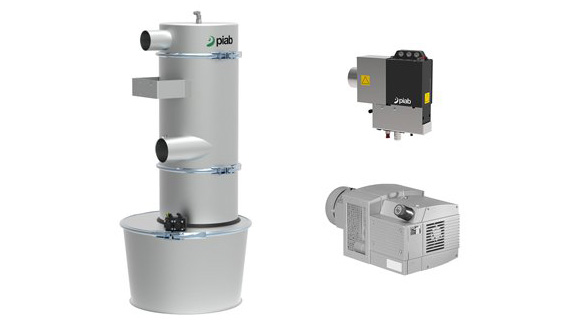Piab Vakuum discusses challenges for vacuum conveying technology in AM
June 18, 2018

The piFLOW®i, one of Piab’s vacuum conveying systems for powders (Courtesy Piab Vakuum GmbH)
Piab Vakuum GmbH, based in Butzbach, Germany, supplies vacuum technology for the conveyance of powders to the Additive Manufacturing and other industries, as well as using AM in the production of individual grippers for use in process automation and robotics. The company has subsidiaries and sales partners in nearly seventy countries, employing approximately 430 staff. In 2017, its total sales reached around SEK 1 billion (€97 million).
In a recent interview with Germany’s Industry Federation of Mechanical Engineers (VDMA), Johannes Krumme, Piab’s Sales Manager Vacuum Conveying, discussed some of the challenges posed for vacuum conveying technology by the metal AM sector, and revealed his expectations for AM process chains in 2030.
Among the challenges highlighted by Krumme was the comparatively high bulk density of metal powders in comparison to powders for other industries, such as in the pharmaceutical and food sectors, which Piab also serves. “In the metal area, powders can weigh up to 8 kg/l,” he explained. “In powder handling with the pharmaceutical and food sector, it is usually about 0.8 to 1.2 kg/l. So we need vacuum systems with a markedly higher power.”
This in turn poses further challenges, he added. While most vacuum conveying technologies transport powder using air flow, reactive metal powders must be transported in a nitrogen or argon atmosphere to prevent contamination or even explosions. “To do this, the gas has to enter into a vacuum system, necessitating a highly complex control,” he stated.
“Other challenges lie in exhaust air flow as well as in the area of explosion protection, of course… We need to be aware that each powder change requires cleaning routines, and that an inert gas atmosphere needs to be ensured in the whole conveying system at all times– and these gases must not leak, for cost as well as for occupational safety reasons.”
Krumme commented that for metal powders, vacuum conveying systems must be tailored to the specific requirements of each alloy. “We are not just talking about one powder but about a multitude of various materials to which we must tailor our solutions individually. Here, we are drawing on our knowhow from industries that are already using our solutions for automated powder handling.”
Much of Piab’s current development is said to be focused on addressing these challenges and supporting its customers in the development and implementation of AM workflows. A key factor enabling the industrialisation of AM is automation, particularly for powder handling.
“We have got the necessary know-how to automate powder handling, as we have been working with that since 1978, especially for the pharmaceutical industry,” Krumme stated. “Depending on the size of the company and throughput of their system, different solutions are in use. At a blockbuster, several systems run with one powder all around the clock. Wherever small batch sizes are produced, the powders keep changing, always requiring a thorough cleaning. This is why we optimise our solutions for fast, efficient cleaning processes.”
Looking to the future of the industry, Krumme reported that by 2030, he expects automation to play a more critical role across the entire AM workflow. “I assume that there will be a fully automated AM process chain with a link to Industry 4.0. In these process chains, vacuum conveyors will independently adjust to various requirements, for example suction and extraction times […] I assume that AM systems will be produced as single-origin, in order to sidestep cleaning efforts and the complexity of gas flow with powder changes.”
The concept of this ‘smart vacuum’ is one which Piab is said to be close to making a reality. “At Piab, this is already coming with piSMART® – our smart, cloud-compatible vacuum solutions,” he explained. “We regard Additive Manufacturing as a new market with large potential; we have suitable products and solutions in our portfolio, and we have got the necessary knowhow to collaborate with partners from the AM sector towards market-specific solutions, particularly in the area of powder handling.”
















